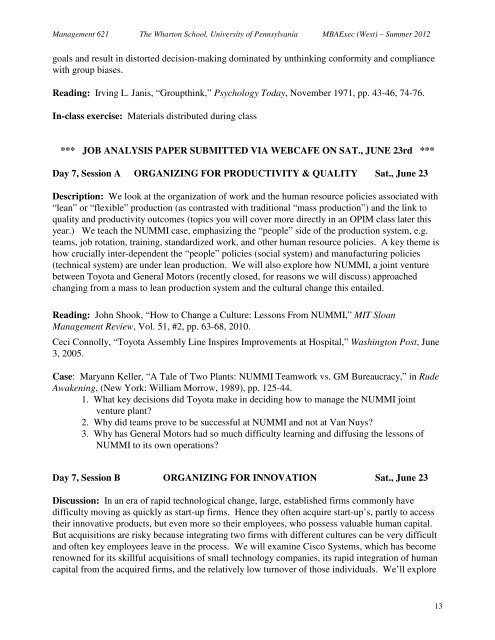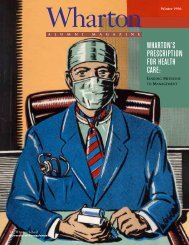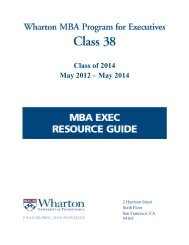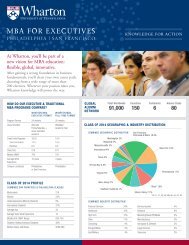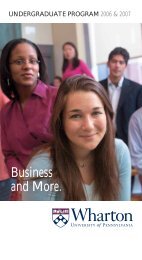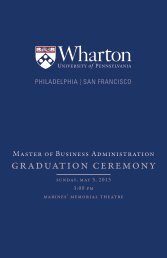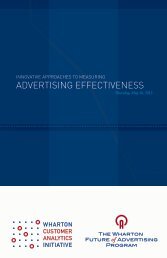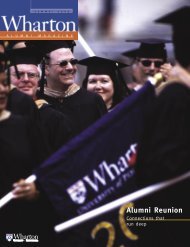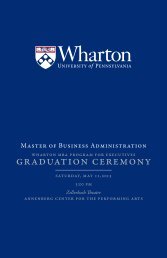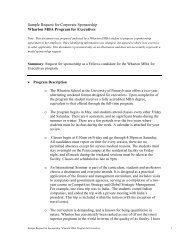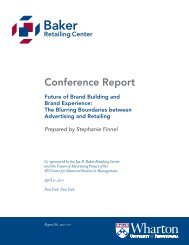version Date: April - The Wharton School of the University of ...
version Date: April - The Wharton School of the University of ...
version Date: April - The Wharton School of the University of ...
Create successful ePaper yourself
Turn your PDF publications into a flip-book with our unique Google optimized e-Paper software.
Management 621 <strong>The</strong> <strong>Wharton</strong> <strong>School</strong>, <strong>University</strong> <strong>of</strong> Pennsylvania MBAExec (West) – Summer 2012<br />
goals and result in distorted decision-making dominated by unthinking conformity and compliance<br />
with group biases.<br />
Reading: Irving L. Janis, “Groupthink,” Psychology Today, November 1971, pp. 43-46, 74-76.<br />
In-class exercise: Materials distributed during class<br />
*** JOB ANALYSIS PAPER SUBMITTED VIA WEBCAFE ON SAT., JUNE 23rd ***<br />
Day 7, Session A ORGANIZING FOR PRODUCTIVITY & QUALITY Sat., June 23<br />
Description: We look at <strong>the</strong> organization <strong>of</strong> work and <strong>the</strong> human resource policies associated with<br />
“lean” or “flexible” production (as contrasted with traditional “mass production”) and <strong>the</strong> link to<br />
quality and productivity outcomes (topics you will cover more directly in an OPIM class later this<br />
year.) We teach <strong>the</strong> NUMMI case, emphasizing <strong>the</strong> “people” side <strong>of</strong> <strong>the</strong> production system, e.g.<br />
teams, job rotation, training, standardized work, and o<strong>the</strong>r human resource policies. A key <strong>the</strong>me is<br />
how crucially inter-dependent <strong>the</strong> “people” policies (social system) and manufacturing policies<br />
(technical system) are under lean production. We will also explore how NUMMI, a joint venture<br />
between Toyota and General Motors (recently closed, for reasons we will discuss) approached<br />
changing from a mass to lean production system and <strong>the</strong> cultural change this entailed.<br />
Reading: John Shook, “How to Change a Culture: Lessons From NUMMI,” MIT Sloan<br />
Management Review, Vol. 51, #2, pp. 63-68, 2010.<br />
Ceci Connolly, “Toyota Assembly Line Inspires Improvements at Hospital,” Washington Post, June<br />
3, 2005.<br />
Case: Maryann Keller, “A Tale <strong>of</strong> Two Plants: NUMMI Teamwork vs. GM Bureaucracy,” in Rude<br />
Awakening, (New York: William Morrow, 1989), pp. 125-44.<br />
1. What key decisions did Toyota make in deciding how to manage <strong>the</strong> NUMMI joint<br />
venture plant<br />
2. Why did teams prove to be successful at NUMMI and not at Van Nuys<br />
3. Why has General Motors had so much difficulty learning and diffusing <strong>the</strong> lessons <strong>of</strong><br />
NUMMI to its own operations<br />
Day 7, Session B ORGANIZING FOR INNOVATION Sat., June 23<br />
Discussion: In an era <strong>of</strong> rapid technological change, large, established firms commonly have<br />
difficulty moving as quickly as start-up firms. Hence <strong>the</strong>y <strong>of</strong>ten acquire start-up’s, partly to access<br />
<strong>the</strong>ir innovative products, but even more so <strong>the</strong>ir employees, who possess valuable human capital.<br />
But acquisitions are risky because integrating two firms with different cultures can be very difficult<br />
and <strong>of</strong>ten key employees leave in <strong>the</strong> process. We will examine Cisco Systems, which has become<br />
renowned for its skillful acquisitions <strong>of</strong> small technology companies, its rapid integration <strong>of</strong> human<br />
capital from <strong>the</strong> acquired firms, and <strong>the</strong> relatively low turnover <strong>of</strong> those individuals. We’ll explore<br />
13


